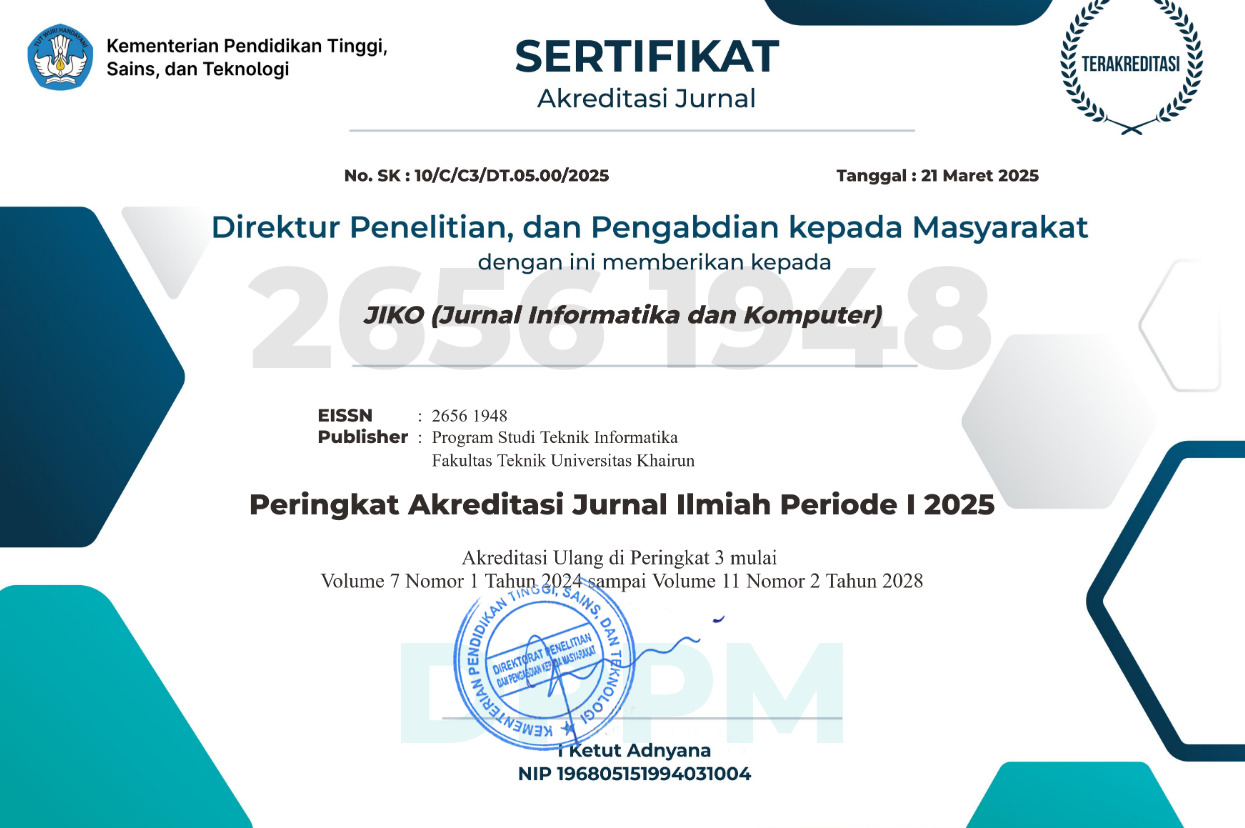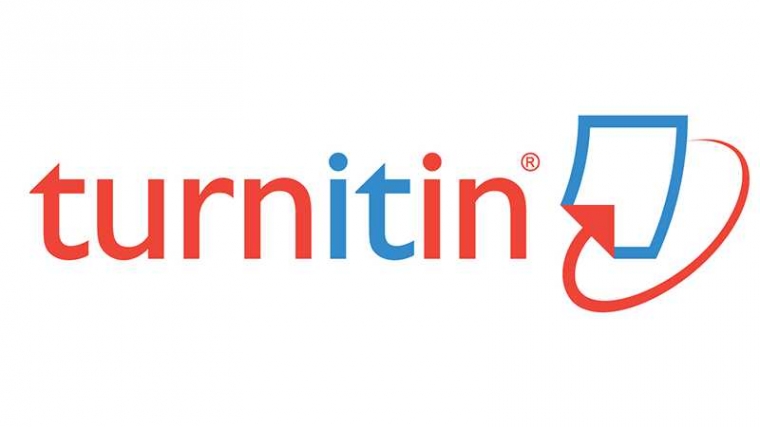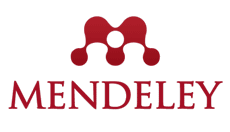QUALITY MANAGEMENT OF INFORMATION TECHNOLOGY GOVERNANCE COBIT 2019 FRAMEWORK EDUCATION FACTORS IN INDONESIA: A REVIEW
Abstract
This study examines information technology (IT) governance in Indonesia's education sector using the COBIT 2019 framework through a systematic literature review (SLR) approach. COBIT 2019 is a globally recognized framework designed to help organizations manage IT effectively by integrating quality management principles to achieve strategic objectives. In the education sector, implementing robust IT governance is crucial to supporting ongoing digital transformation efforts. The SLR process involved identifying, selecting, and analyzing relevant literature to assess the implementation of COBIT 2019 in the Indonesian education sector. The findings indicate that this framework can enhance IT governance quality, particularly in risk management, resource efficiency, and operational sustainability. However, challenges persist, including limited managerial understanding, shortages of skilled human resources, and inadequate infrastructure support. To address these challenges, collaboration among the government, educational institutions, and the private sector is essential. Additionally, continuous training programs are necessary to enhance the competencies of management and IT personnel in effectively implementing COBIT 2019. The study underscores the importance of integrating technological and educational aspects to improve service quality in the education sector. Furthermore, the COBIT 2019 framework is recognized as a valuable tool for fostering collaboration among stakeholders to achieve sustainable education development in Indonesia.
Full Text:
PDFReferences
R. L. V. Nyoto and N. Nyoto, “Analisis Kapabilitas Tata Kelola Teknologi Informasi Perguruan Tinggi Xyz Menggunakan Cobit 2019,” JOISIE (Journal Inf. Syst. Informatics Eng., vol. 7, no. 1, pp. 25–34, 2023.
R. Anugrah, E. Utami, and A. H. Muhammad, “Analisis Manajemen Risiko TI Pada Perguruan Tinggi XYZ Berbasis COBIT 2019 Dengan Pertimbangan Domain APO12,” J. Ilm. Univ. Batanghari Jambi, vol. 22, no. 2, p. 991, 2022, doi: 10.33087/jiubj.v22i2.2175.
A. S. Sukamto, H. Novriando, and A. Reynaldi, “Tata Kelola Teknologi Informasi Menggunakan Framework COBIT 2019 (Studi Kasus: UPT TIK Universitas Tanjungpura Pontianak),” J. Edukasi dan Penelit. Inform., vol. 7, no. 2, p. 210, 2021, doi: 10.26418/jp.v7i2.47859.
O. Kristiana, “Analisis Tata Kelola Teknologi Informasi Pada Sistem Informasi Akademik (SIAKAD) Menggunakan Framework Cobit 2019 (Studi Kasus STMIK Pringsewu),” Anal. Tata Kelola Teknol. Inf. …………………….……, vol. 11, pp. 11–21, 2022.
A. Fitri and J. Hartono M, “Evaluasi Penerapan Tata Kelola Teknologi Informasi (TI) Menggunakan Framework Cobit 2019 (Studi Kasus pada Perguruan Tinggi Harapan Maju),” ABIS Account. Bus. Inf. Syst. J., vol. 11, no. 3, p. 225, 2023, doi: 10.22146/abis.v11i3.86440.
A. Ghufran Yuda, D. Takratama Savra, F. Rahmat Halim, M. Ripaldo Pratama, and N. Safiq Tama, “Audit Tata Kelola Universitas Islam Negeri Sultan Syarif Kasim Riau Kuliah Kerja Nyata Sistem,” J. Test. dan Implementasi Sist. Inf., vol. 2, no. 1, pp. 10–17, 2024.
P. D. Setyadi et al., “Audit Strategi Tata Kelola It Pada Stmik Bina Nusantara Jaya Lubuklinggau Menggunakan Framework Cobit 5 Governance Strategy Auditorium Of It At Stmik Bina Nusantara Jayalubuklinggau Using The Cobit 5 Framework,” Cogito Smart J. |, vol. 8, no. 1, pp. 244–258, 2022.
M. Destriani and Y. H. Putra, “Rencana Audit Tata Kelola Sistem Informasi Di Universitas Subang Menggunakan Framework COBIT 2019,” J. Tata Kelola dan Kerangka Kerja Teknol. Inf., vol. 9, no. 1, pp. 19–33, 2023, doi: 10.34010/jtk3ti.v9i1.9164.
S. Dwi Putra, H. Herman, and A. Yudhana, “Evaluasi Tata Kelola Layanan Jaringan Menggunakan COBIT 2019 Pada Sekolah Tinggi Ilmu Kesehatan,” Resist. (Elektronika Kendali Telekomun. Tenaga List. Komputer), vol. 5, no. 2, p. 119, 2022, doi: 10.24853/resistor.5.2.119-126.
A. Sulistiyono, “Evaluasi Tata Kelola dan Manajemen Risiko Unit Teknologi Informasi dan Pangkalan Data pada Perguruan Tinggi Keagamaan Islam Negeri XYZ dengan Menggunakan Framework COBIT 2019,” vol. 5, no. 4, pp. 1914–1926, 2024.
B. Angel M, Pangaribuan, and S. Fernandez, “Tata Kelola Teknologi Informasi Menggunakan COBIT 2019 Pada Val,” J. Ilm. Komput. Graf., vol. 16, no. 1, pp. 196–208, 2023, [Online]. Available: https://doi.org/10.51903/pixel.v16i1.1247.
Y. Sangka, L. Indrayani, P. S. Komputer, and P. S. Informasi, “Rekomendasi tata kelola teknlogi informasi menggunakan cobit 2019 dikampus xyz,” vol. 7, pp. 377–385, 2024, doi: 10.37600/tekinkom.v7i1.1323.
M. A. Saputra and M. R. Redo, “Penerapan Framework Cobit 2019 Untuk Perancangan Tata Kelola Teknologi Informasi Pada Perguruan Tinggi,” J. Sci. Soc. Res., vol. 4, no. 3, p. 352, 2021, doi: 10.54314/jssr.v4i3.715.
M. Saleh, I. Yusuf, and H. Sujaini, “Penerapan Framework COBIT 2019 pada Audit Teknologi Informasi di Politeknik Sambas,” J. Edukasi dan Penelit. Inform., vol. 7, no. 2, p. 204, 2021, doi: 10.26418/jp.v7i2.48228.
L. Satria Kusuma, H. Purnomo, and Wasilah, “Penilaian Tata Kelola Teknologi Informasi Menggunakan Framework Cobit 2019,” J. JUPITER, vol. 16, no. 2, pp. 413–423, 2024.
M. Ardiyanto, “Audit Tata Kelola Sistem Informasi Kerja Praktik Pada Universitas Duta Bangsa Surakarta Menggunakan Framework Cobit 2019,” vol. 14, no. 2, pp. 166–172, 2024.
N. Marthiawati, K. Kurniawansyah, and R. Aryani, “Analisis Kinerja Tata Kelola Teknologi Informasi Menggunakan Framework Cobit 2019 Pada Universitas Muhammadiyah Jambi,” J. Ilm. SINUS, vol. 22, no. 1, p. 11, 2023, doi: 10.30646/sinus.v22i1.760.
M. Muthmainnah, S. Safwandi, M. Jannah, and V. Ilhadi, “Evaluasi Tata Kelola Teknologi Informasi Menggunakan Framework Cobit 5 Proses Dss03 Dan Mea01 Di Universitas X,” Sisfo J. Ilm. Sist. Inf., vol. 5, no. 1, pp. 1–12, 2021, doi: 10.29103/sisfo.v5i1.4848.
A. Nasiri, “Evaluasi Tingkat Kapabilitas Keamanan Sistem Informasi Menggunakan Kerangka Kerja Cobit 2019,” J. Tata Kelola dan Kerangka Kerja Teknol. Inf., vol. 9, no. 1, pp. 34–41, 2023.
H. Maulana et al., “Penyesuaian Sistem Tata Kelola Pada Institut Teknologi Kalimantan Dengan Menggunakan Cobit 2019 Pelayanan Teknis ( UPT ) dan tim ad hoc . Salah satu tugas pengelola TI di perguruan tata kelola teknologi informasi adalah Control Objective for Information a,” J. Sist. Inf., vol. 12, no. 2, pp. 2060–2074, 2020.
C. Burgers, M. Jong Tjien Fa, and A. de Graaf, “A tale of two swamps: Transformations of a metaphorical frame in online partisan media,” J. Pragmat., vol. 141, pp. 57–66, 2019, doi: 10.1016/j.pragma.2018.12.018.
L. H. Atrinawati et al., “Assessment of Process Capability Level in University XYZ Based on COBIT 2019,” J. Phys. Conf. Ser., vol. 1803, no. 1, 2021, doi: 10.1088/1742-6596/1803/1/012033.
R. Prasetya, A. H. Muhammad, and A. Nasiri, “Perancangan Model Manajemen ( Tata Kelola ) Data Menggunakan Domain Apo14 Cobit 2019 Studi Kasus : Fakultas Syariah Iain Ponorogo,” pp. 389–396, 2021.
R. Fadhilah, “Rencana Audit Teknologi Informasi Menggunakan Cobit 2019 Pada Unit Isti Universitas Telkom,” JIKO (Jurnal Inform. dan Komputer), vol. 4, no. 3, pp. 157–163, 2021, doi: 10.33387/jiko.v4i3.3325.
H. Nurcahya, E. Setiawan, and B. Permana, “Information Technology Governance Audit Using COBIT Framework 2019 (Case Study: Mandiri University),” Budapest Int. Res. Critics Inst. Humanit. Soc. Sci., vol. 5, no. 1, pp. 8030–8038, 2022.
S. Samsinar and R. Sinaga, “Information Technology Governance Audit at XYZ College Using COBIT Framework 2019,” Berk. Sainstek, vol. 10, no. 2, p. 58, 2022, doi: 10.19184/bst.v10i2.30325.
A. Ishlahuddin, P. W. Handayani, K. Hammi, and F. Azzahro, “Analysing IT Governance Maturity Level using COBIT 2019 Framework: A Case Study of Small Size Higher Education Institute (XYZ-edu),” 2020 3rd Int. Conf. Comput. Informatics Eng. IC2IE 2020, no. September 2020, pp. 236–241, 2020, doi: 10.1109/IC2IE50715.2020.9274599.
F. Ajismanto and S. Surahmat, “Information Technology Governance Analysis Of Stmik Palcomtech In The New Normal Era Using Cobit 2019 Method,” J. Comput. Networks, Archit. High Perform. Comput., vol. 3, no. 2, pp. 263–272, 2021, doi: 10.47709/cnahpc.v3i2.1097.
F. Febrianti and D. N. Utama, “Enhancing IT maturity in the DevOps focus area: a comprehensive assessment with COBIT 2019,” Edelweiss Appl. Sci. Technol., vol. 8, no. 4, pp. 926–934, 2024, doi: 10.55214/25768484.v8i4.1472.
L. N. Amali, M. R. Katili, and S. Suhada, “Core model of information technology governance system design in local government,” Telkomnika (Telecommunication Comput. Electron. Control., vol. 21, no. 4, pp. 750–761, 2023, doi: 10.12928/TELKOMNIKA.v21i4.24287.
T. R. McIntosh et al., “From COBIT to ISO 42001: Evaluating cybersecurity frameworks for opportunities, risks, and regulatory compliance in commercializing large language models,” Comput. Secur., vol. 144, no. November 2023, p. 103964, 2024, doi: 10.1016/j.cose.2024.103964.
David, E. Abdurachman, A. Bandur, and W. Kosasih, “Improving Competitive Advantages of Higher Education Institutions through IT Governance, IT Excellence, and IT Innovation: A Case Study in School of Informatics Management & Computing in Indonesia,” CommIT J., vol. 17, no. 1, pp. 103–119, 2023, doi: 10.21512/COMMIT.V17I1.8505.
K. Alshammari et al., “Cultivating Success: Unveiling the Influence of Higher Education Strategies on Information Technology Governance, Academic Excellence, and Career Prospects in Saudi Arabia,” Sustainability, vol. 16, no. 12, p. 5025, 2024, doi: 10.3390/su16125025.
M. E. Torres-Moreno and J. H. Aponte-Melo, “Assessing business-IT alignment maturity at a Colombian university,” J. Cases Inf. Technol., vol. 23, no. 4, 2021, doi: 10.4018/JCIT.20211001.oa8.
C. Abdelilah, S. Ahriz, K. El Guemmat, and K. Mansouri, “Building a Specialized It Governance Strategy for Higher Education: a Strategic Model,” J. Comput. Sci., vol. 20, no. 7, pp. 768–782, 2024, doi: 10.3844/jcssp.2024.768.782.
DOI: https://doi.org/10.33387/jiko.v8i1.9498
Refbacks
- There are currently no refbacks.











